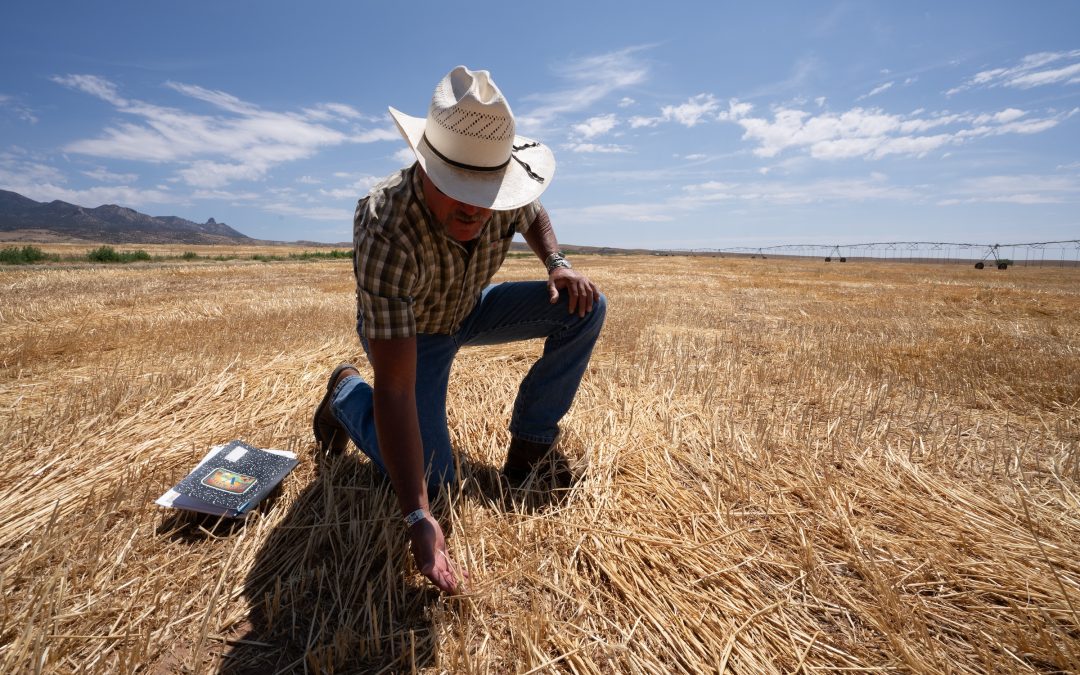UTE MOUNTAIN UTE RESERVATION — In southwestern Colorado, Greg Vlaming crouched down to look at dying remains of an oat crop baking under the July sun. It wasn’t just a dead plant — it was armor, he said.
“This minimizes wind erosion and surface runoff,” said Vlaming, a soil scientist, consultant and farmer. “Water can’t run off on something that’s like this.”
Vlaming is working alongside the state, researchers, farmers and ranchers on a newly expanded soil health program established by the Colorado legislature in 2021. The goal of the program is to nurture soils in order to reap rewards — like more efficient irrigation, more carbon storage and healthier crops.
But changing long-standing growing practices can be a risky, expensive challenge for farmers already dealing with drought and thin margins. That’s why the state spent this year building out resources, like traveling soil specialists, for anyone who wants to try its soil health practices, said John Miller, Soil Health Program administrator for the Colorado Department of Agriculture.
“They spend pretty much every day of the week on the road meeting with producers … and we can’t do it fast enough,” Miller said. “They want more.”
For almost all of the last 24 years, parts of Colorado have experienced some level of drought. Farmers and ranchers are used to dealing with swings in precipitation, but if there are multiple poor water years in a row, their crops, livestock and bottom line can suffer.
They are also facing increasing pressure to cut back on their water use as Western states grapple with gaps between the demand for water and the supply in river systems like the Colorado River Basin, the source for 40 million people and about 5.5 million acres of agricultural land.
Already in Colorado, about 20% of the agricultural demand for water goes unmet each year, according to the 2023 Colorado Water Plan. By 2050, that gap could widen by 150,000 to 200,000 acre-feet per year, depending on the location.
One acre-foot roughly equals the annual water use of two to three households.
The Colorado Soil Health Program team aims to help farmers and ranchers stay in business whether there’s drought, low reservoir storage, poor market prices for their crops or a new influx of pests.
Improving soils is one way to make that happen, Vlaming said.
“If you’re holding more water, you’re building pest resistance, you’re building resilience to drought, you’re building vigor in the plant and higher yields,” he said.
Microbes: Where the magic happens
In the field at the Ute Mountain Ute Farm and Ranch in southwestern Colorado, Vlaming checked his cell phone, where he could access real-time measurements from a soil sensor.

“Look what it shows me,” he said. “We’re super dry.”
Ideally, the soil is about 17% to 40% saturated with water, depending on the soil texture. As soils become more saturated, it can lead to flooding, erosion and runoff. This field — already cut and no longer irrigated — was at 15%.
Farmers can use these soil readings to time when their center pivots will swing over the field and sprinkle water over the crops.
“You’re not going by intuition, and you’re going, ‘Welp, field’s dry, let’s irrigate,’” Vlaming said. “It’s like no, we know exactly how dry we are. That’s part of this program. … It’s just so cool.”
The soil health program focuses on building up organic matter, like decaying roots and plant leaves, and increasing microbial diversity in the soil.
Keeping a few inches of plant stubble on the ground after harvesting a crop is one method. The program also encourages farmers to minimize soil disturbance, increase the diversity of plants grown on the field, keep live plant roots in the soil and integrate livestock into farming practices.
More organic matter helps store carbon, cuts down on pest problems, boosts nutrients, provides aeration that helps roots grow and stabilizes crop yields.
It also acts like a sponge: For every 1% increase in organic matter, the soil can store roughly 20,000 to 27,000 gallons of additional water per acre, according to Miller and the Natural Resources Conservation Service.
That means a farmer can wait longer before irrigating again, using less water on a particular field and opening up water supplies. They can reinvest that extra water in their business or even conserve it as part of efforts like the System Conservation Pilot Program, a federal program that pays farmers to cut their water use.
Growing without organic matter is like growing something on Mars, Miller said.
“Organic matter is the key to everything,” he said. “If it’s just dirt, just the mineralized portion, that water is not going to stay there at all.”
Mindset and money
The Ute Mountain Ute Indian Tribe, which owns the Farm and Ranch, has 10 fields in the state soil program, most of which are using at least one soil health principle.
“It’s gonna be a good program for us to be able to monitor and stay on top of our soil health program along with our water placement and usage,” said Simon Martinez, who manages the 7,700-acre operation.
The Farm and Ranch is one of 300 producers that enrolled in the three-year program this summer. It’s the second iteration of the program: In 2022, 120 producers enrolled and are wrapping up their participation this summer. The total number of farms and ranches in Colorado as of 2022 is 38,800, according to a 2023 federal agricultural statistics report.

There’s still a lot of work to do, said members of the soil health team during a tour of the Farm and Ranch on July 30.
The main challenge is money and mindset, they said.
People who want to try a different soil health practice, like minimizing disturbance of the soil, might not have access to a less disruptive tiller. They might want to leave stubble to armor the soil’s surface, but they can’t afford machinery with a giant roller that creates a mat on the soil’s surface.
Or they heard that their neighbor tried to grow a new crop to increase the plant diversity, and it was a costly failure.
“Anything experimental can lead to a failure. … When you have the type of thin margins that ag operations do, costly failures can’t be happening,” Miller said. “It’s a good way to go out of business.”
The state’s soil health program helps pay for the costs of trying out the new practices, and the team’s soil specialists offer on-site advice to help people test out the new soil practices.
“It’s not a lot of money, but the idea is to change the mindset in the management decisions,” Vlaming said. “It values soil health in your decision-making.”
Through the program, sociologists are talking to producers about barriers to changing practices. Researchers are doing economic case studies to understand the financial impacts. They’re gathering hard data on water retention, the quality of runoff, greenhouse gas emissions and carbon sequestration.
“We want to know more about what those microbes are and what they’re doing,” Miller said.



 Print
Print